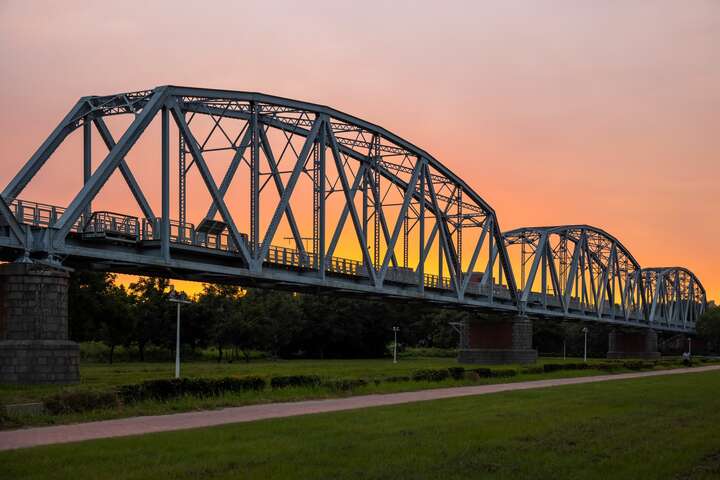Old Iron Bridge Wetland Education Park (Dashe Old Iron Bridge) Introduction
The Old Iron Bridge Wetland Education Park is located in Dashu District, spanning from the Xiejian Bridge to the Gaoping Bridge on the right bank of the Gaoping River, covering an area of 300 hectares. The riverside features hydrophilic walkways, riverside bike paths, natural ecology zones, park green spaces, and a café plaza. Among these, the Old Iron Bridge Wetland Ecological Park occupies over 100 hectares. This vast and picturesque wetland education park combines the unique and numerous religious, cultural, historical sites, natural ecology, water conservancy culture, and scenery of Dashu District, making it a distinctly unique recreational and educational destination in Taiwan. It is the best scenic spot along the Gaoping River, rich in plant and animal ecology, serving as a great place for family learning and play, as well as an ideal location for photographers. The awakening light at sunrise and the sunset reflecting off the water create stunning scenic views. The "Gaoping Old Iron Bridge" within the park is a national historical monument, completed in 1913. Like a rainbow, it spans the Gaoping River, connecting the railway transportation of the two Gaoping regions, marking an important chapter in Taiwan’s livelihood and economic development. It was the longest iron bridge in Asia at the time. Through revitalization and restoration, it has now become the Old Iron Bridge Sky Walk, featuring a viewing platform for visitors to relax. The bridge, originally named the Lower Tamsui River Iron Bridge, was constructed under the supervision of Japanese engineer Iida Toyoji and completed in 1913. It is a single-track iron bridge with a total length of 1,526 meters, consisting of 24 groups of steel trusses and granite brick piers, connecting the railway transport between the two Gaoping regions. After over a century, the Old Iron Bridge has retired from its service, but its historical, cultural, and architectural significance is worth preserving. In 2014, marking the 100th anniversary of the bridge's construction, the city government revitalized and restored it on the principle of "not damaging any original components," creating a 307-meter-long and 8-meter-wide sky walk. Steel plates were installed in the gaps of the wooden sleepers to provide walking and bike-pushing pathways and a viewing platform for resting. Walking along the sky walk allows for close encounters with the beauty of historical monuments and bridge architecture, with trains roaring by beside you. The lush wetlands and beautiful mountains and rivers along the Gaoping River showcase multi-layered splendor in the morning and evening light, providing a chance to enjoy natural scenery and experience historical richness, broadening one's mind and spirit. The Old Iron Bridge Wetland Park is situated between the Old Iron Bridge and the Gaoping Bridge, where 13 artificial ponds were excavated. Utilizing aeration, sedimentation, and the purification functions of microorganisms, it achieves natural purification of water sources. The wetland park insists on not using herbicides, maintaining ecological conservation along the banks of the Gaoping River, creating a friendly environment for plant growth and habitats for birds and aquatic animals. In this vibrant green area, visitors can fully enjoy natural scenery via well-developed paths and bike lanes, closely observe hundreds of species of wildlife and aquatic plants, while the rich natural ecology and serene riverside scenery provide the best enjoyment for both the eyes and the soul. The Gaoping River Barrage requires a formal application for entry. Given the uneven rainfall in southern Taiwan and the increasing water demand, the Gaoping River Barrage was built within the Dashu District of Kaohsiung City, located two kilometers upstream from the Gaoping Railway Bridge. Since its operation in 2000, its daily water intake accounts for 63% of the daily water consumption in the Greater Kaohsiung area, making it the most significant water source for the region. The barrage stretches 960 meters in total, with a fixed weir of 674 meters, and 8 movable rubber dams totaling 286 meters, equipped with a "fishway" for migratory fish to ascend for spawning. This barrage only raises water levels without storage capacity; it uses the country's first domestically made rubber dam to hold water during low water levels and release water downstream during periods of high water flow, contributing significantly to river safety and water sourcing while minimizing ecological damage. The barrage management office also houses a Water Resource Museum, providing detailed illustrations and descriptions of the sustainable use of Gaoping River water resources, carrying significant educational value.





































